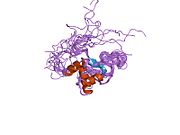PLEK2
Protein-coding gene in the species Homo sapiens
| PLEK2 | |||||||||||||||||||||||||||||||||||||||||||||||||||
|---|---|---|---|---|---|---|---|---|---|---|---|---|---|---|---|---|---|---|---|---|---|---|---|---|---|---|---|---|---|---|---|---|---|---|---|---|---|---|---|---|---|---|---|---|---|---|---|---|---|---|---|
 | |||||||||||||||||||||||||||||||||||||||||||||||||||
| |||||||||||||||||||||||||||||||||||||||||||||||||||
| Identifiers | |||||||||||||||||||||||||||||||||||||||||||||||||||
| Aliases | PLEK2, pleckstrin 2 | ||||||||||||||||||||||||||||||||||||||||||||||||||
| External IDs | OMIM: 608007; MGI: 1351466; HomoloGene: 8447; GeneCards: PLEK2; OMA:PLEK2 - orthologs | ||||||||||||||||||||||||||||||||||||||||||||||||||
| |||||||||||||||||||||||||||||||||||||||||||||||||||
| |||||||||||||||||||||||||||||||||||||||||||||||||||
| |||||||||||||||||||||||||||||||||||||||||||||||||||
| |||||||||||||||||||||||||||||||||||||||||||||||||||
| |||||||||||||||||||||||||||||||||||||||||||||||||||
| Wikidata | |||||||||||||||||||||||||||||||||||||||||||||||||||
| |||||||||||||||||||||||||||||||||||||||||||||||||||
Pleckstrin-2 is a protein that in humans is encoded by the PLEK2 gene.[5][6][7] The PLEK2 gene is located on chromosome 14 in Homo sapiens and is flanked by TMEM229B to its right and ATP6V1D to its left.[8]
References
- ^ a b c GRCh38: Ensembl release 89: ENSG00000100558 – Ensembl, May 2017
- ^ a b c GRCm38: Ensembl release 89: ENSMUSG00000021118 – Ensembl, May 2017
- ^ "Human PubMed Reference:". National Center for Biotechnology Information, U.S. National Library of Medicine.
- ^ "Mouse PubMed Reference:". National Center for Biotechnology Information, U.S. National Library of Medicine.
- ^ Lemmon, Mark A.; Ferguson, Kathryn M.; Abrams, Charles S. (2002). "Pleckstrin homology domains and the cytoskeleton". FEBS Letters. 513 (1): 71–76. doi:10.1016/S0014-5793(01)03243-4. PMID 11911883.
- ^ Hamaguchi N, Ihara S, Ohdaira T, Nagano H, Iwamatsu A, Tachikawa H, Fukui Y (Aug 2007). "Pleckstrin-2 selectively interacts with phosphatidylinositol 3-kinase lipid products and regulates actin organization and cell spreading". Biochem Biophys Res Commun. 361 (2): 270–5. doi:10.1016/j.bbrc.2007.06.132. PMID 17658464.
- ^ "Entrez Gene: PLEK2 pleckstrin 2".
- ^ "AceView: PLEK2 gene". AceView. National Library of Medicine. Retrieved 24 April 2011.
Further reading
- Bach TL, Kerr WT, Wang Y, et al. (2007). "PI3K regulates pleckstrin-2 in T-cell cytoskeletal reorganization". Blood. 109 (3): 1147–55. doi:10.1182/blood-2006-02-001339. PMC 1785144. PMID 17008542.
- Inazu T, Kuroiwa A, Matsuda Y, Miyamoto K (2005). "Cloning, expression and chromosomal assignment of human pleckstrin 2". Mol. Biol. Rep. 32 (1): 35–40. doi:10.1007/s11033-004-4747-x. PMID 15865208. S2CID 8131790.
- Gerhard DS, Wagner L, Feingold EA, et al. (2004). "The status, quality, and expansion of the NIH full-length cDNA project: the Mammalian Gene Collection (MGC)". Genome Res. 14 (10B): 2121–7. doi:10.1101/gr.2596504. PMC 528928. PMID 15489334.
- Strausberg RL, Feingold EA, Grouse LH, et al. (2003). "Generation and initial analysis of more than 15,000 full-length human and mouse cDNA sequences". Proc. Natl. Acad. Sci. U.S.A. 99 (26): 16899–903. Bibcode:2002PNAS...9916899M. doi:10.1073/pnas.242603899. PMC 139241. PMID 12477932.
- Inazu T, Yamada K, Miyamoto K (1999). "Cloning and expression of pleckstrin 2, a novel member of the pleckstrin family". Biochem. Biophys. Res. Commun. 265 (1): 87–93. doi:10.1006/bbrc.1999.1461. PMID 10548495.
- Hu MH, Bauman EM, Roll RL, et al. (1999). "Pleckstrin 2, a widely expressed paralog of pleckstrin involved in actin rearrangement". J. Biol. Chem. 274 (31): 21515–8. doi:10.1074/jbc.274.31.21515. PMID 10419454.
- Hillier LD, Lennon G, Becker M, et al. (1997). "Generation and analysis of 280,000 human expressed sequence tags". Genome Res. 6 (9): 807–28. doi:10.1101/gr.6.9.807. PMID 8889549.
- v
- t
- e
PDB gallery
-
 1v3f: Solution structure of the DEP domain of mouse pleckstrin2
1v3f: Solution structure of the DEP domain of mouse pleckstrin2 -
 1x1g: Solution structure of the C-terminal PH domain of human pleckstrin 2
1x1g: Solution structure of the C-terminal PH domain of human pleckstrin 2
 | This article on a gene on human chromosome 14 is a stub. You can help Wikipedia by expanding it. |
- v
- t
- e




















